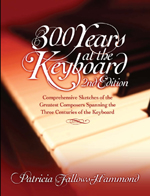Composer Example: Mozart
We have produced a 312 page book that covers 17 of the greatest classical keyboard composers in history. For each composer we give a historical sketch of the composer, commentary on their style, commentary on their more important works and sample sheet music they have produced. We follow this with a comprehensive list of all their works so if you like what a composer is like you can instantly go order some or all of their sheet music.
In this discussion, we will give you a sample of the presentation we do for each composer.
Wolfgang Amadeo Mozart
Born in Salzburg, Austria, January 27, 1756
Died in Vienna, Austria, December 5, 1791,
Age 35 years
Historical Sketch
The earliest compositions attributed to Mozart appeared in his father Leopold’s writing in the Nannerl Notebook of 1759 which Leopold compiled and named for Mozart’s older sister. It contains material from contemporary composers arranged progressively for her instruction. Between 1761 and 1763, Leopold Mozart added Wolfgang’s first works to the collection. As the only intellectual at the Salzburg court chapel for many years, Leopold held a unique place among his musical contemporaries. He composed many symphonies, masses, chamber works, keyboard sonatas, and theoretical works. Among the latter was his famous Violinschule, published in 1756, the year Wolfgang was born. It ranks in importance with C.P.E. Bach’s Treatise on the Art of Clavier Playing of 1753.
Leopold was an ambitious man who saw nothing wrong in showing off Wolfgang’s exceptional talents to the public and using every possible occasion to advance his own reputation and livelihood. Exploitation and opportunism certainly entered his management of Wolfgang and Nannerl’s early years. However, his incessant advice which continued through letters into Wolfgang’s later years did not alter Wolfgang’s high spirits, affection, eagerness to learn, independence of musical thought, or charming irresponsibility which kept him impecunious most of his life.
The strength of Mozart’s genius, choosing and discarding influences as he saw fit, made him the most universal composer the Western world has known. He was supreme in every form of musical expression, and he used every tool of composition with perfection.
At 5, Mozart made his first public appearance at Salzburg University. The next two years saw performances before the Elector of Bavaria, Empress Maria Theresa, and the court of Salzburg. On the strength of Mozart’s dazzling success at improvising, his father decided to storm Paris with visits to every important musical center on the way. There were concerts in Munich, Augsburg, Mainz, Frankfurt, and Brussels before the Mozarts reached Paris. In Paris, young Mozart played before Louix XV at Versailles and published his first works, 2 pairs of Sonatas for keyboard and violin. He also met Baron Friedrich Melchior Grimm, of literary fame (Correspondence Littéraire), who was later a helpful friend. After five months in Paris, Mozart and his father went to London where they stayed for over a year. While there, Mozart played for King George III. He met Johann Christian (the London) Bach with whom he improvised on the harpsichord. At this time, 1764-5, he composed his first symphonies. For the next five years, Mozart’s travels took him back to Paris briefly, to Vienna where he composed the Singspiel, Bastion und Bastienne, and to Salzburg where his opera buffa, Lafinta simplice, was performed. He was made an honorary Konzertmeister to the Salzburg court.
In 1770, Mozart’s father took him to Italy where he was still considered a child prodigy and drew an admiring and gift-giving public. Mozart wrote his first String Quartet K.80/73f outside Milan and successfully produced his opera, Mitridate, Ré di Ponto, which had 22 performances. In Rome, he performed the remarkable feat of memorizing Allegri’s Miserere after one hearing at the Sistine Chapel. Mozart returned to Salzburg and composed there until the end of 1773 with short visits to Italy. This was a fertile period in which he wrote 12 Symphonies, 8 Divertimentos, a new opera, Lucio Silla, string quartets, and the solo motet, Exsultate, jubilate.
By the end of 1773, Leopold Mozart looked toward better financial prospects for his son. His own finances were stable because of his employment at the Salzburg court under Archbishop Hieronymus and the gifts he received on tour. Father and son spent the following year in Vienna. Wolfgang composed with growing variety and intellectual maturity a series of works which included 6 String Quartets, the first Piano Concerto K.175, and two additional Concertos, one for two violins and orchestra and one for bassoon and orchestra. Mozart returned to Salzburg in 1775……………
Style
Bach and Handel brought the Baroque era to its close, while Haydn and Mozart created and defined the new Classical Era. Each set of composers shared characteristics of the particular musical span but wrote with unmistakable individuality. A study of Bach’s contrapuntal style by the side of Handel’s operatic and choral methods gives a clear profile of each composer. With Haydn and Mozart, surface differences are harder to find because both composers used contrapuntal texture freely, added supple melodies which were not an outgrowth of counterpoint, and developed true harmonic feeling. But in general, it was Haydn who defined the method and Mozart who expanded it.
Contrast of themes and variety of key relationships were among the foundations of the sonata form of the Classical Era. Haydn exemplified these ideals. Mozart not only incorporated them but pushed the developing form of the piano sonata and piano concerto to the limits of pure Classicism where Beethoven’s further innovations waited. The perfection and variety of Mozart’s art are expressed in melodies of exceptional beauty, harmonic progressions which include free use of discord, and lilting rhythms. The piano works embody these characteristics as they do the drama and emotion of the operas, symphonies, and string quartets. Mozart’s remark that melody is the essence………..
Compositions:
Sonata in D major K.284 (1775)
In this Sonata, for the first time, Mozart wrote a true Theme and Variations as an entire last movement. The Variations possess chromaticism, full-bodied sound, and the brightness of concerto style, meeting the request of Baron Durnitz for a work of difficulty and virtuosity.
To supplement the first six Sonatas, Mozart created a fresh repertoire while on tour in Mannheim and Paris with seven new Sonatas. The first two,……….
Lots more…….More about the publication, including reviews by major magazines and sample pages from the book can be found by clicking here:
![]()



